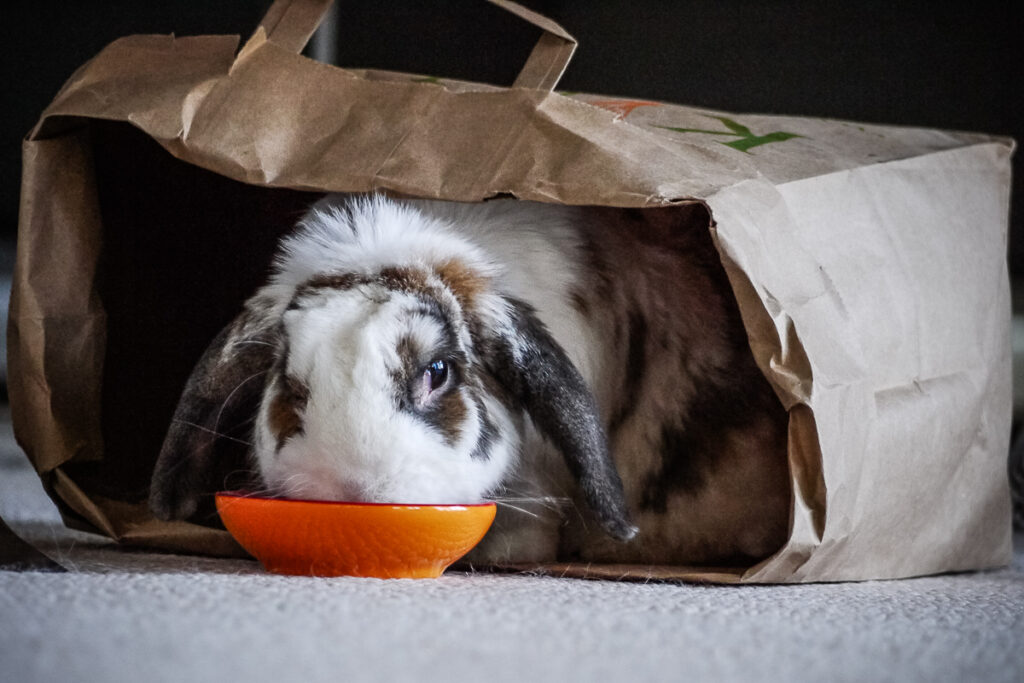Experienced rabbit people know it’s just a passing phase, but if this is your first bunny and you brought her home last spring, you are seeing a number of transitions and personality changes. Your Easter bunny is now a teenager. You have learned that you are living with an intelligent creature, who is curious about the world and investigates it with her teeth and toenails.
This is the time of year that many of last Easter’s impulse buys wind up in animal shelters. But that won’t happen to your Easter bunny, because you are willing to learn how to cope with rabbit adolescence. A previous article “Rebel With Paws,” will guide you through this difficult period.
Rabbit adolescence is one of several phases that you will see in your rabbit. Other stages also include behavior changes. Some changes are obviously age related. Others are more obscure.
Misdirected blame
The stage of intense curiosity, hyperactivity and frantic chewing and digging occurs at the height of adolescence. This is also about the time that we recommend spaying or neutering. People often expect an overnight cure for what they consider behavioral problems. But what are we trying to “cure,” hormonally induced behavior or age related behavior? The former will be eliminated by spay/neuter surgery, but the latter will still have to run its course. Sometimes the surgery itself is blamed for behavior that has nothing to do with the surgery but commences at the same time.”She didn’t chew and dig before the surgery, but she does now.”
A possibly reason is that she was spayed before she reached adolescence. Now that she’s experiencing adolescent urges, it may appear that nothing (behavioral) has been accomplished. I tell people not to expect dramatic or abrupt changes and that it can take as long as eight months for a recalcitrant rabbit to calm down. I’m implying that it takes that long for the hormone level to drop in some rabbits, but that also allows some time for maturity.
One rabbit adopter asked if neutering could have been the cause of increased cecal droppings. He didn’t have the problem before the surgery, I was told. The surgery just happened to coincide with his living in a new home and indulging in a richer diet.
We know for a fact that some rabbit behavior is of a developmental nature and not hormonally induced. In some shelters where animals are spayed routinely, rabbits are spayed or neutered at a very young age. These bunnies grow up in a normal way and express their adolescence at the chronologically correct time. Their adolescent stage may be a little less intense than with intact animals. But we should not expect and should not want our rabbits to entirely lose their natural urges to chew, dig, explore, and claim territory. It is our human responsibility to provide outlets for these needs.
Bi-level bunny proofing
Some rabbits from our earliest rescues were never adopted and have continued to live with us. As they settled in, they became very easy to manage. I assumed this was due to my impeccable bunny-proofing techniques. I forgot for a while what it was like to have a teenage rabbit in the house-then along came Ruby. I thought our phone cords were hidden well enough. I had forgotten that a computer chair must be pushed all the way under the desk when left unoccupied. Otherwise it can be used as a springboard by a whiskered explorer to access the desktop. The expression of adolescence took its toll on two of our phone cords and a modem cord in one day. We then lost our mouse, printer cables, S-video, and BNC cables (and I have given classes on bunny proofing!).
As I pondered my slip-ups in bunny proofing, I realized that what had been appropriate for Bandit, our office rabbit, is not adequate now for Ruby-Jewel, his teenage bride. Maybe we should reclassify bunny proofing into different safety levels, depending on the ages of the rabbits, but when mixed ages are involved, maximum security must be used.
Mature Behavior
We have watched over the years as our rabbits have become more mellow. The behavior of an older rabbit differs in several ways. Senior rabbits, move about a little slower, but they are still willing and able to learn new routines. Litterbox habits are still present, but some older rabbits have trouble getting into the box (cutting down the side is suggested). They sleep a lot more but wake up plenty eager for their treats.
We don’t worry that much about property destruction from our elderly rabbits. We work towards encouraging them to chew. We keep them supplied with toys and exercise, and we revel in the fact that some are passing their tenth year.
Few people want to adopt older rabbits, probably due to fear of losing them too soon. A consideration in adopting a healthy older rabbit is that, while you may not be able to look forward to a prolonged period of time with your bunny, it can be a good trouble-free time.
May-December Matches
The fact that young and old rabbits have very different behaviors may cause some reluctance on the part of adopters to mix the ages. A study conducted at U.C. Davis in 1991 suggested that there was less fighting among rabbits of the same age.
In our foster homes, we have not found this to be necessarily so, even though behaviors do differ with age. Once bonded, rabbits tolerate a wide range of behavior in each other. Bandit and Jewel, mentioned above, both meet us at the door. She springs; he hobbles. Her affection to him is shown in activity. She dances, pushes, nudges, and thrusts her head under his chin to be groomed. His affection to her is shown in relaxation, by grooming her ears, then stretching out beside her with his rear legs extended.
Jefty lost his companion last year. In his grief, he started wasting away, and his hair fell out in large blotches (metabolic derangement, our veterinarian called it). He lost coordination and was unable to make the small jump into his cage at night. The tonic for this middle-aged gentleman of 6 years has turned out to be the matronly 11-year-old Sieglinda, who had also lost her companion last year.
Only a person with Sieglinda’s experience, wisdom, confidence, and gentility could restore Jefty’s will to survive. He has regained his weight, his hair, and his coordination. When Sieglinda was younger, she was more aloof and would not have offered Jefty what she does today. At this moment in time, their needs are perfectly matched.
Through the ages
In our companion rabbits we can expect many behavioral changes during the course of a lifetime. Most of these are of a developmental nature brought about by normal aging cycles. We monitor behavior not so much to alter it but to provide outlets for our rabbits’ psychological needs and to alert ourselves to abnormal behavior changes that may indicate illness. Our job is to keep them safe through the age of intense investigation and to pay attention to them during the age that they demand less attention.

